The boat is
still and silent. The sailing adventure is over. At times over the last week
this was the moment I looked toward. Now that it’s here, I question why. The
sea has a conflicting magnetism: when
you’re on water you look to be on land; and when you’re on land you once again
wish for the solitude of sea life.
 |
| Passing Isle du Golfe, on the way to Port Davey and the South West Wilderness. |
When we
lived in Tasmania for five years awhile back, we explored the main island
extensively in our campervan, and on our departure in
Delvy. There were
some on water activities too: club yacht racing on the Derwent River, longer
races in the D’éntrecasteaux Channel and the Launceston to Hobart; inshore
exploring in our 1975 Pongrass speedboat; and in recent times a few yacht
deliveries, but never any cruising. We were looking forward to returning. Our 103-day,
3000 nautical mile journey from South East Queensland to Tasmania and back was
a trip of a lifetime. Here is what made it so memorable.
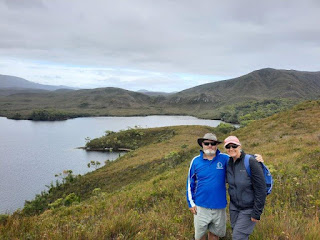 |
| View from Clyde's Hill, South West Wilderness |
By sea
Seeing
stuff from the water gives a whole new perspective of a place. Tasmania with
its 334 islands is a remarkable cruising ground full of bays, inlets and coves
just waiting to be explored. We were on our own voyage of discovery. You know that
first time you see something? Oh, the magic and wonder of it. There were so
many wow moments. So much untouched wilderness; crisp, clean, unpolluted air
and clear, (cold) water, and we usually had it all to ourselves.
Spectacular
anchorages abound. One standout is Canoe Bay in Fortescue Bay on the Tasman
Peninsula. Tucked in behind the remains of a steel-hulled barge, the William
Pitt, scuttled there in 1955 to provide a breakwater, we could escape the
ocean swell and anchor in a pond that backs onto the heavily forested Tasman
National Park. Sailing past 300-metre-high dolerite columns, the tallest sea
cliffs in the Southern Hemisphere, to get there was astounding.
 |
| Beautiful view from Canoe Bay of The Lanterns and Cape Huay in the distance |
Besides the
different perspective, some places are only accessible by sea making it all the
more adventurous. The start of the Three Capes Track is reachable by boat only:
I had my own private dinghy drop off and enjoyed a there and back bushwalk to
the first night’s campsite. Deal Island, part of the Kent Group in the middle
of Bass Strait, is attainable only by seafarers, and sailing the Southern Ocean
to the South West Wilderness is the pi
èce de résistance for
any mariner.
 |
| Had the Three Capes Track all to myself before the dedicated transfer boat arrived. |
 |
Beautiful East Cove anchorage on Deal Island - it's a short steep walk up the hill
to the museum and caretakers cottage. |
There are some
things you learn best in calm, and some in storm. -Willa Cather
Seamanship
Having read
about it, planned for it, and then for it to actually happen is extremely
rewarding. To use all of one’s skills and available resources to get there and
back safely, overcome challenges along the way, is a grand achievement. Just to
get to Tasmania from Brisbane (and return) is an epic journey in itself. We’re
no strangers to crossing Bass Strait but respect is still demanded from this
infamous body of water. Our crossings were a walk in the park compared to the
waters off the NSW South Coast.
 |
| It's moments like these that make it all worthwhile. |
Gary as an
experienced skipper and engineer enjoyed the challenges of a new cruising
ground, and bore the responsibility of ensuring the ongoing safety and comfort
of crew and vessel. A marvellous, courageous job. Being able to sail his old
school friends to the South West Wilderness World Heritage Area in our own
boat,
Jobey Doh, was an ‘underpants on the outside’ moment. Actually, it
was for quite a few days (and they were big underpants). Sailing from Hobart to
Recherche Bay, followed by a two day wait for favourable weather to make the
full day’s voyage around South East Cape into the Southern Ocean to Port Davey,
the Bathurst Channel, and Melaleuca Inlet. We spent three wonderfully
glorious, off the grid sunny days exploring this uninhabited wilderness that we
have read so much about in stories of the naturalist and tin miner
Denny King,
and cray fishers
Win & Clyde, the first and last permanent residents from
the 1940’s to 1970’s. The isolation is immense, the landscape vast, the silence
commanding, and the weather is master. Although we had some luck on our side,
as the weather window held out for us to sail back ‘around the corner’
comfortably in our allotted timeframe.
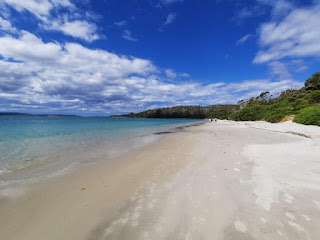 |
| Reherche Bay, a lovely place to hang out and wait for a weather window for safe passage to Port Davey. |
 |
| After 12 hours of sailing/motoring from Recherche Bay we made it to the South West wilderness. |
 |
Time to explore on shore.
|
 |
| I wonder how any boats have tied up here at Claytons Corner over the years. |
 |
The only way to access the South West wilderness is by plane, on foot via the South Coast Track,
or by boat. |
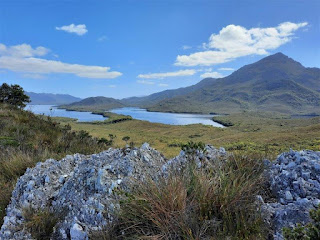 |
| Mt Rugby dominates the landscape. |
 |
| Full moon rising, through the binoculars. |
Tasmanian
weather can change very rapidly, even in the summer months, and with little
visual warning. Weather watching becomes a full-time occupation using various
available forecasting models, and tapping into local knowledge. We were
fortunate to have very little rain over the three months, the driest summer in
40 years, and only had a couple of exceptional blowy days of 40 plus knots.
Confident with our anchoring gear, we sought a sheltered anchorage (making sure
the internet connection was adequate for some Netflix viewing), battened down
the hatches and enjoyed a rest day from constant exploring or journeying
activities.
 |
| We didn't move an inch during the blow; neither did the other eight boats seeking shelter. |
At sea, anything
can happen at any time so need to be prepared to act on a moment’s notice, as
a matter of survival. But also planning extensively is part of good seamanship: anticipate different scenarios and
formulate contingencies. Being constantly switched on can be exhausting; but if it was easy, everyone would do it.
 |
| It was tough hanging out on the beach all afternoon while making dinghy repairs. |
Nature
The beauty
(and at times bane) of being on the ocean is that at all times we’re fully
immersed in the natural world, bearing witness to its varying moods and
offerings. Sun, sea, sky, wind, clouds, stars, and the lunar phases are the
headline acts; dolphins, sunfish, jellyfish, gulls, albatrosses, shearwaters
and gannets make regular guest appearances.
 |
| Always difficult to get a decent photo as dolphins are so quick, but have much more success than capturing a bird in flight. |
The
geological features of the Tasmanian coastline were the most fascinating. The
Devonian granite belt of Freycinet, Bay of Fires and Flinders Island; the Precambrian
quartzite-rich mountains of the South West Wilderness; and the magmatic dolerite
columns of the Tasman Peninsula were simply striking. On shore, native dry and
wet eucalypt forests made for wonderful bushwalking with an abundance of
birdlife and macropods for company, and cliff top and ridge trails providing
the best views.
 |
| Coles Bay on the Freycinet Peninsula is a popular tourist destination as it's easily accessible by car. |
 |
| Dolerite columns rising 300 metres from the sea |
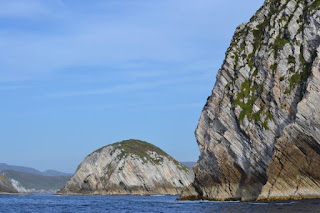 |
| Captivating rock formations in Port Davey. |
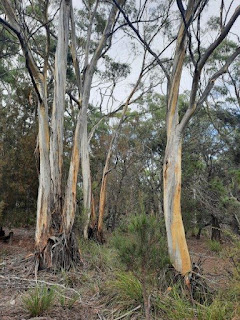 |
| The scent of the Australian bush is very distinct after fresh, sea air. |
 |
| Drive the Chasm, the challenging Par 3, 8th hole tee off. |
The
unexpected wonder of Maria Island had us returning for a second visit. I
couldn’t get enough of the cute wombats and the Harry Potteresque Cape Barren geese.
The colonial history also intriguing; convict and industrial ruins weathered by
time and nature. Our brief visit to Flinders Island has us wanting to come back
to explore its history and the Furneaux GeoTrail further. The alluring
isolation of Deal Island with its dramatic sea cliffs and pretty sandy coves also
demands a repeat visit. Not to mention spending more time in the South West,
the last bastion of wilderness.
 |
| Many remnants of past industry are dotted around Maria Island |
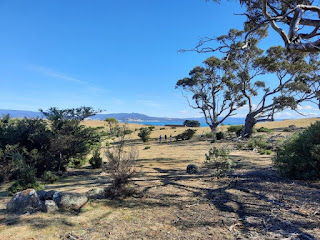 |
| Maria Island has many fabulous and varied bushwalks |
 |
| Robeys Farm, left vacant since the 1960s and still standing |
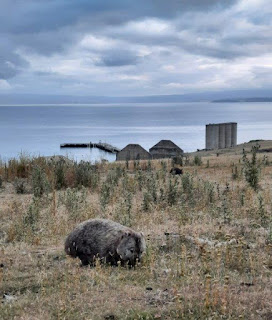 |
| From sunset onwards you're guaranteed to see many wombats on Maria Island. |
The long
summer days allowed us to pack so much in each. Sometimes though we wished for darkness
to hurry up so we could rest our weary bodies, but the endless Monet sunsets kept
us on deck as they were just too good to miss. Carpe diem.
 |
| Another sublime sunset on anchor |
‘’For the most
part, a sailboat navigates through its world of wind and water not leaving a
single trace of its passage. Nothing is consumed. Nothing is altered. The winds
and the water are left in exactly the same condition for the next user. Sailing
is forever’’. -Michael B. McPhee
Sailing
There were champagne
sailing moments, character-building moments, and everything in between. A
response to a call out on the Women Who Sail Australia network had us enjoying an
extra hand and company on the southbound leg to Port Hacking. A wild electrical
storm off Montague Island had us wondering what we were doing, but after a six-day
layover in Eden and another easy Bass Strait crossing, we eased into it and were
excited to finally arrive in Tasmania, 16 days from our Scarborough departure.
 |
| Morning after the electrical storm on our way to Eden. |
Coincidently,
one of the other brown pants moments was in the same area on our return leg:
seas built to three metres from behind with the wind at 30 plus knots, much
greater than forecasted on our departure from Eden that morning. We had to pull
over in Bermagui which meant crossing the bar. Miraculously, another big yacht
appeared out of nowhere and made for the entrance, so we followed and tied up just
before sunset at opposite ends of the fuel wharf, the only available space in
the small marina. After a big day of hand steering in the heavy weather with a
left-over easterly swell we were pretty wired. A fish and ship dinner from the
co-op was prescribed followed by retiring to our respective corners with
headphones. Only to be awoken with a bang as something ran into us. A very large
(and very expensive) sailing vessel had also come in from the bad weather and
was trying to squeeze in between us and the other yacht. The irony wasn’t lost;
its name was
Obscurity.
 |
The three metre waves from behind with an easterly cross swell was too much for the autopilot,
so it was handsteering to Bermagui. |
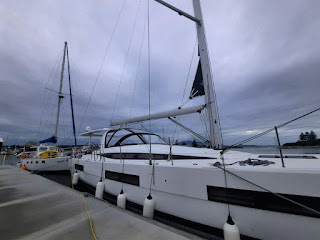 |
| Safe and sound alongside Bermagui fuel wharf. |
Confused
seas make for uncomfortable sailing, and that’s pretty much what we had for the
whole return leg. At least the wind abated but the clinks, bangs, thuds, and squeaks
from cupboards are a constant source of annoyance as different movements create
different noises at different times. Just when you think you’ve silenced the
percussion and are once again reclining for some rest, another instrument pipes
up. Uncomfortable sailing also means a limited range of culinary delights; a
cold sausage, peanut butter on bread or perhaps a microwaved chilli bean mix. That’s
why we prefer smooth sailing as meals become more gourmet (and calorific), like
a pancake breakfast, toasted sandwiches or a bacon and egg fry up complete with
a cup of hot tea. Once we even BBQed while enjoying a lazy downwind sunset
sail.
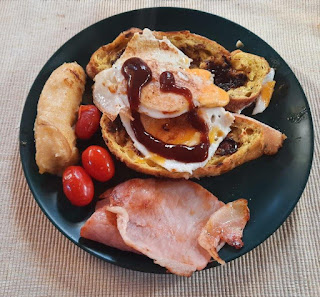 |
| After a 72 hour leg, a cooked breakfast was the best |
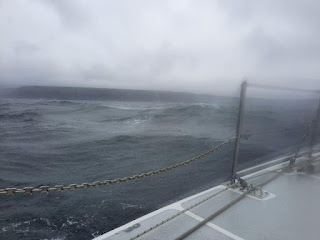 |
| Our only real wet day on the water on the whole trip: from Bermagui to Port Hacking |
By far the
best sail of this trip was from Deal Island to Lakes Entrance (another
favourite cruising ground). With a steady 8-10 westerly on the beam, we sailed
across Bass Strait for the whole 24 hours. I know, that’s slow, an average of
only 4.5 knots an hour, but the autopilot did all the work (easily) while we
read books, alternated naps, soaked up the sun, did a few boat jobs, and
watched the marine life come and play. This is what it’s all about. Hours and
hours of nothing interspersed with no moments of sheer terror, just for a
change.
 |
| A marvellous day exploring on shore at Deal Island before departing with the tide to Victoria. |
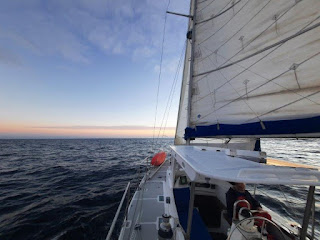 |
| Bass Strait can be beautiful - just need to pick the weather window, and have a little bit of luck. |
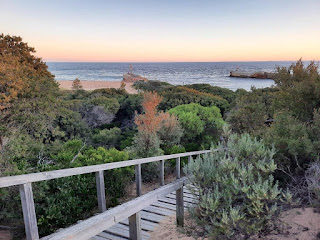 |
| The Lakes Entrance bar was flat like this when we crossed a few hours earlier. |
People
The lack of
human contact on the big blue sea is part of the attraction, but with those
whom we connected along the way enriched us with kindness and fun. It’s people
that make the journey. Some friends and family accompanied us on sailing
adventures; others visited Jobey-Doh for coffee and an onboard tour. Offers
of long hot showers, a washing machine (being able to play the piano while I
waited was a real treat), an on-land sleepover, a meal, a car for provisioning
and picking up parts: all were so welcomed.
 |
It was good to be able to tie up the boat to visit friends.
We also did a yacht delivery to Melbourne, as you do when one is on a boating holiday! |
A chance
encounter with strangers on a deserted beach turned into a dinner invitation to
their 1830’s whitewashed walled woodcutter’s cottage. Another encounter on
another beach with someone who knew someone we knew. And an unknown couple who
had been following our adventures on social media introduced themselves when we
tied up at Lakes Entrance public jetty. We met fellow cruisers, swapping
stories and information. We enjoyed a morning beach walk and bush bash on Erith
Island with two Tasmanian kayakers while we were all waiting for a south
westerly blow to pass through. Tea, cake and a chat with the Deal Island
caretakers will be another enduring memory. The fleeting shared moments and
experiences with strangers is the drawcard of travel, and the mutual shared
adventures with friends is priceless.
 |
| Meeting the kayakers on Erith Island |
 |
| This wonderful public facility at Sullivan's Cove allowed us to catch up with Hobart friends. |
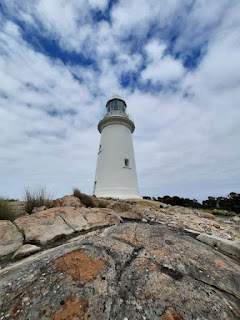 |
Now decommissioned, the Deal Island lighthouse is worth the 3km trek from the
caretakers residence for a look. |
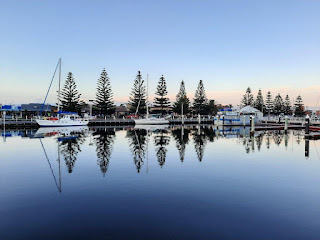 |
| Lakes Entrance jetty, so convenient for reprovisioning and for people to drop by and say hello. |
Did I
mention that Tasmania is a spectacular cruising ground? Made all the more so
with comfortably accessible public infrastructure courtesy of Maritime and
Safety Tasmania (MAST). There are numerous public moorings and jetties dotted
around the state, right on the doorstep of National Parks and various towns.
Being able to berth overnight for free (permission sought prior) in Sullivan’s
Cove right in the heart of Hobart was just fantastic. Triabunna Wharf was also
a frequented favourite with fuel, supermarket, laundromat, public transport and
the best fish chips all within arm’s reach. It’s nice to feel so welcomed, plus
have easy access for restocking before once again venturing out to explore the captivating
coastline of Australia.
 |
This conveniently placed public mooring made it easy to go ashore and explore
the Port Arthur Historic Site. |
 |
| A quiet day this time at the Triabunna Wharf: usually there are fishing boats tied up. |
 |
| Trousers Point: amazing scenery and intriguing name. Will have to come back here one day. |
Now we are
safely tied up in harbour (although that’s not what ships are for) after a two-week
journey from Lakes Entrance. We have returned to a world of crowds, cars, cash
and keys; and barking dogs. Such a contrast from the big, blue sea. However,
Delvy
has been waiting patiently, and when the piggy bank is refilled, it will be time
for a land adventure. How lucky are we?
 |
An eerie feeling silently slipping north past the string of 50 plus anchored ships.
We knew when we were off Newcastle Port as we could smell the coal
drifting on the light westerly breeze. |
 |
At last, some calm water but not enough breeze to turn the engine off as we
slowly cruise through the Gold Coast Inland Waterway. |
 |
| Home for a little while. |
 |
| Ready for another Delvy adventure |














































No comments:
Post a Comment